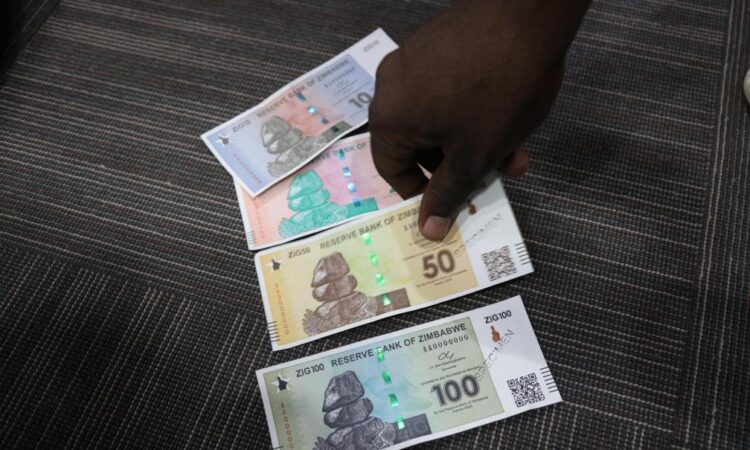

This photo taken on April 5, 2024 shows specimens of new Zimbabwean dollar notes in Harare, Zimbabwe. Zimbabwe on Friday introduced to the market the much-awaited structured currency that monetary authorities expect to foster currency stability and contain rising inflation.
The new structured currency, known as the Zimbabwe Gold (ZiG), will be backed by a basket of foreign exchange reserves and precious metals, mainly gold, being held by the Reserve Bank of Zimbabwe (RBZ), or the country’s central bank. (Photo by Shaun Jusa/Xinhua)
HARARE, April 5 (Xinhua) — Zimbabwe on Friday introduced to the market the much-awaited structured currency that monetary authorities expect to foster currency stability and contain rising inflation.
This is the latest attempt by the central bank to address Zimbabwe’s currency challenges, having in the past launched several currencies, including the current bond notes that have been significantly eroded by high inflation.
The new structured currency will therefore replace the bond notes and other forms of electronic currency such as the Real Time Gross Settlement (RTGS) that have been in circulation.
The new structured currency, known as the Zimbabwe Gold (ZiG), will be backed by a basket of foreign exchange reserves and precious metals, mainly gold, being held by the Reserve Bank of Zimbabwe (RBZ), or the country’s central bank.
“So what is going to anchor this currency is reserves in the form of foreign currency or by commodities such as gold. ZIG shall at all times be anchored and fully backed by a composite basket of reserves comprising foreign currency, precious metals mainly gold received by the RBZ as part of in-kind royalties and kept in vaults by the central bank,” new RBZ Governor John Mushayavanhu said while presenting the 2024 monetary policy statement in the capital Harare.
He said the new currency notes are in denominations of 1, 2, 5, 10, 50, 100 and 200, as well as half and a quarter of ZiG coins to be introduced in due course.
Mushayavanhu said with effect from Monday next week, all Zimbabwean dollar bank balances will be converted to ZiG accounts using the exchange rate of 1 U.S. dollar to 13.56 Zimbabwean dollars.
“The starting exchange rate has been determined by the prevailing closing interbank exchange rate as of April 5 and the London PM Fix price of gold as at April 4, 2024. The intervening exchange rate shall be determined by the inflation differential between ZiG and USD inflation rates and the movement in the price of the basket of precious minerals held as reserves,” he said.
Mushayavanhu said the foreign currency balances will be accumulated through market purchases from the 25 percent foreign currency surrender requirement for exporters, as well as the sale of some precious minerals other than gold.
Subsequent to this, the inter-bank rate will be market-determined but mostly influenced by the price of gold, and also the exchange rates of other currencies in the multi-currency basket as well inflation differentials, he said.
Mushayavanhu said the monetary policy statement, which is traditionally released in February of each year, was delayed to allow for wider consultations, including with the International Monetary Fund and the World Bank.
“So with effect from today, the 5th of April 2024, banks shall convert the current Zimbabwe dollars balances into the new currency which shall be called the ZiG to foster stability, simplicity, certainty and predictability in our financial affairs,” he said.
“All Zimbabwean dollar notes and coins held by account holders will be credited into their ZiG accounts using the applicable conversion rate. The banks will continue to accept these deposits for a period of 21 days after today,” Mushayavanhu said.
He said the Know Your Customer (KYC) requirements will apply to individuals with more than 100,000 Zimbabwean dollar notes.
“If anyone is going to bring in notes worth above 100,000 dollars, we need to know where you got it and why you have been keeping it,” he said. ■

New governor of Reserve Bank of Zimbabwe (RBZ) John Mushayavanhu presents the 2024 monetary policy statement in Harare, Zimbabwe, April 5, 2024.
Zimbabwe on Friday introduced to the market the much-awaited structured currency that monetary authorities expect to foster currency stability and contain rising inflation.
The new structured currency, known as the Zimbabwe Gold (ZiG), will be backed by a basket of foreign exchange reserves and precious metals, mainly gold, being held by the Reserve Bank of Zimbabwe (RBZ), or the country’s central bank. (Photo by Shaun Jusa/Xinhua)

